
- OCD JOURNAL vol.4 no.1
- 2013.03.27
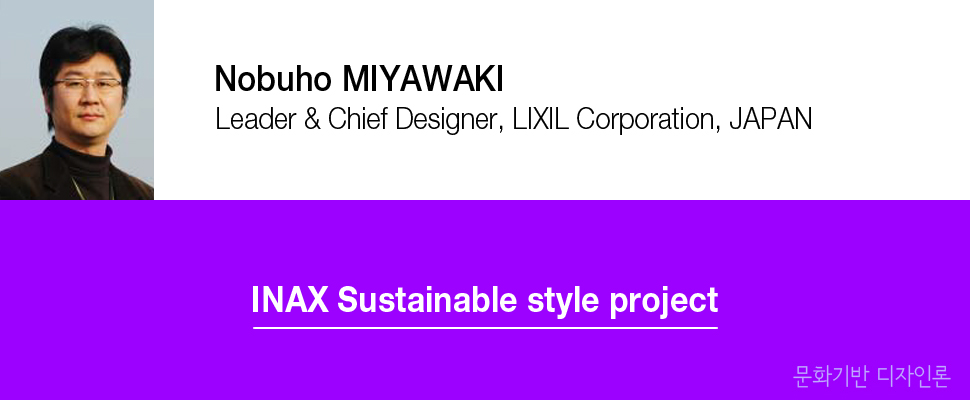
Abstract
The activities of the INAX Sustainable Style Project, which we worked on for 6 years from 2002 to 2007, are described below.
This project aimed to create technology, products, and services for a sustainable society that is in harmony with the global environment based on material recycling - a society that lives with new values.
Having set 2020 as the year by which to create a sustainable society in terms of the basic actions of everyday life bathing, eating, and elimination, we imagined what each of these areas of life would be like and how people would live their lives in this age, and we developed products and services that would become necessary. Conventional ideas of “advanced design” are based on predictions of what society and the technologywill be like in 3 to 5 year’s time. This can more accurately be termed “forecasting”. It is highly effective when looking at the near future, but if there are large changes that have remained hidden and are waiting to happen, it can lead to extremely dangerous choices.
On the other hand, in order to prevent making the wrong choice over the long term, it is important to establish goals to work toward. This is the “sustainable design” method that is based on such a sustainable future. It involves establishing what a sustainable society of the future should look like and then to look back from this future to the present and to think about what needs to be done by when. This method is known as “backcasting”. We believe that the actions that make us happy in the present may not necessarily lead to happiness going into the future. What really makes us, our families, and our friends happy? Our hope for this project was to find a wayto work for our happiness in the present and the happiness of future generations.
(Keyword)
Lifestyles, New values , Sustainable, Environment ,necessary in 2020
1. Background of Design
Realizing a sustainable society - one that is based on material recycling and that is in harmony with the global environment is a goal that we must achieve. In recent years we have come to seriously question whether our daily habits and actions, which may work towards keeping us satisfied at present time, will truly bring about happiness for ourselves, as well as our family members and friends in the future. It is this way of thinking that has emboldened us to seek out a new path that will allow us to achieve happiness, not only for ourselves in the present, but for future generations as well.
We believe that how INAX as a corporation can continue to create customers and continue operating as a company with a meaningful existence depends on how we are able to respond to the needs of a recycling society and how much of a driving force we can be in such a society. To this end we need not only marketing methods that address the here and now but also a vision for creating the future.
2. Concept of Design
To this end, it is imperative for the INAX Corporation to offer design solutions that are innovative and set standards for comfortable living, while providing the resident with a lifestyle that evokes a heightened state of awareness.
It is important to note that this endeavor also prompted us to move forth with the actual creation of the technologies, products and services that we feel are necessary to the realization of our goal. Having designated 2020 as the year by which we expect to see a sustainable society in terms of the basic actions of our everyday lives – namely, “bathing”, “eating” and “elimination” (which also happen to fall within our field of business), we imagined what each of these areas of life would be like and how people would live their lives in this age. At the same time, we were able to propose designs for several products and services that we envisioned as necessary toward this end (prototype designs that we call ”sustainable evidence”).
Examples of these designs included the ” Cultivation Kitchen
”, the “Foam Bath” and the “Deposit Toilet”. It is important to note that this endeavor also prompted us to move forth with the actual creation of the technologies, products and services that we feel are necessary to the realization of our goal. Having designated 2020 as the year by which we expect to see a sustainable society in terms of the basic actions of our everyday lives – namely, “bathing”, “eating” and “elimination” (which also happen to fall within our field of business), we imagined what each of these areas of life would be like and how people would live their lives in this age. At the same time, we were able to propose designs for several products and services that we envisioned as necessary toward this end (prototype designs that we call ”sustainable evidence”). Examples of these designs included the ” Cultivation Kitchen”, the “Foam Bath” and the “Deposit Toilet”.
Modern-day kitchens use excessive amounts of water and are the source of much food waste. Instead of just using water a single time and simply disposing of it, with the kitchen we propose, one can re-use the water a second or a third time, after which the remaining water can be used to water a vegetable garden and any unusable water that is left over is finally disposed of. Additionally, this kitchen would also be capable of converting food refuse to compost. The above are just a few examples of the free flowing movement of materials and natural resources we envision in our design. As part of our vision for a “Cultivation Kitchen” we also hope to offer a lifestyle that is surrounded by affluence and natural greenery, as well as one in which people can safely and securely grow their own produce. We proposed the “Cultivation Kitchen” with young families in mind because it can help the parents teach their children about food safety and security and to be thankful for the food they eat. We believe that even in urban apartment buildings, where plants would be grown under artificial light, this kitchen would provide a good opportunity to learn about and enjoy food.
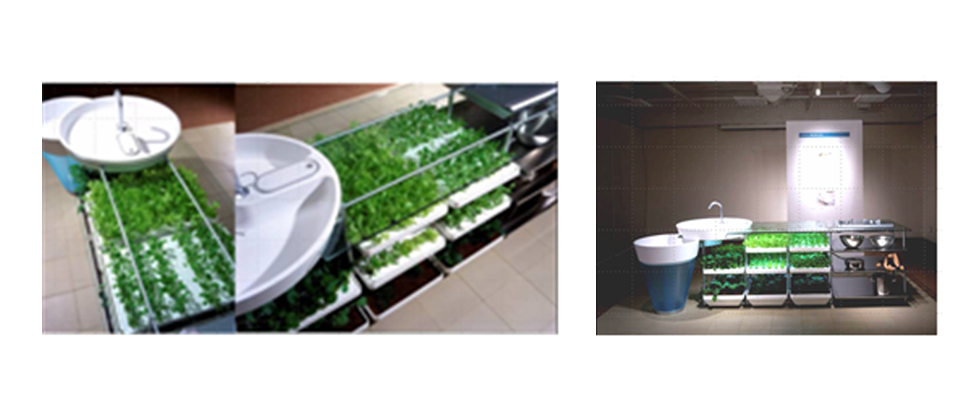
[Figure 1] Foam Bath
[Figure 2] Cultivation Kitche
In regards to bathing, we focused on elderly people who live alone. Japanese baths, which use large amounts of water even for a single person, may become outmoded in the coming age. The “Foam Bath” that we conceived provides the user with a warm bath by immersing them in foam bubbles, and uses only 1/20 the amount of water used in present-day bathing.
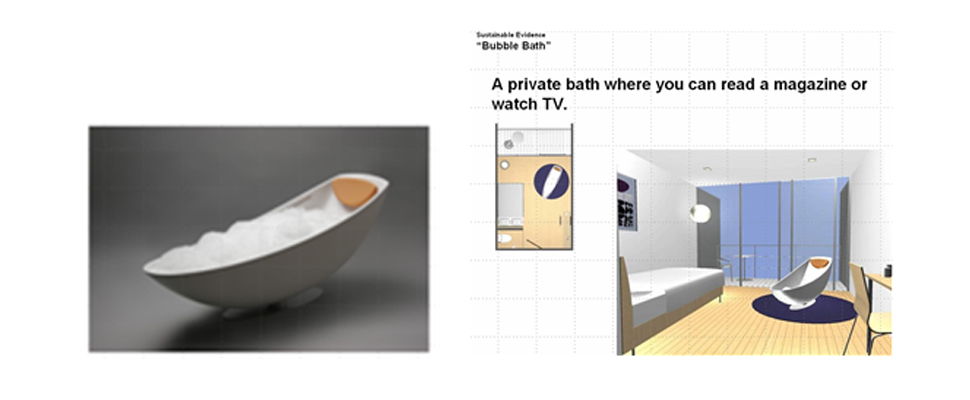
[Figure 3] Foam Bath
Additionally, as this method of bathing requires very little equipment, it could drastically revolutionize the very concept of bathing. It could transform bathing from an act that is performed exclusively in the bathroom, to one that you can take with you to other rooms in your house, or even outdoors. Because only lightweight bubbles have to be maintained, a rigid container is not required. A thin film used to contain the bubbles could conceivably function as the bathtub, which may allow resource use to be minimized here as well.
Finally, in regards to elimination, we do not view bodily waste as useless refuse - we believe methods of recycling can transform it to an important organic resource. As we currently use water to wash away this waste in order to collect and recycle it, we are forced to expend considerable energy to remove moisture from the waste, so that it can be processed. In order to solve this problem, we propose a method to transport this waste that does not involve water, but uses a powder containing microorganisms instead. We imagine a situation in which urban office buildings are converted into sustainable apartment buildings featuring this type of toilet, and that these apartment buildings would be inhabited by people with a certain lifestyle in mind. This lifestyle would include recycling one’s own waste to grow vegetables and livestock that could end up on one’s dinner plate – an idea that would not be readily accepted right away by most people. However, we do imagine this would be a meaningful choice for people who find happiness and enjoyment in this way of life.
To accomplish our goals in each of the above cases that we have presented as evidence, we are currently trying to develop products that challenge our established ways of living, and provide a convenient way for us to shift to more sustainable living.
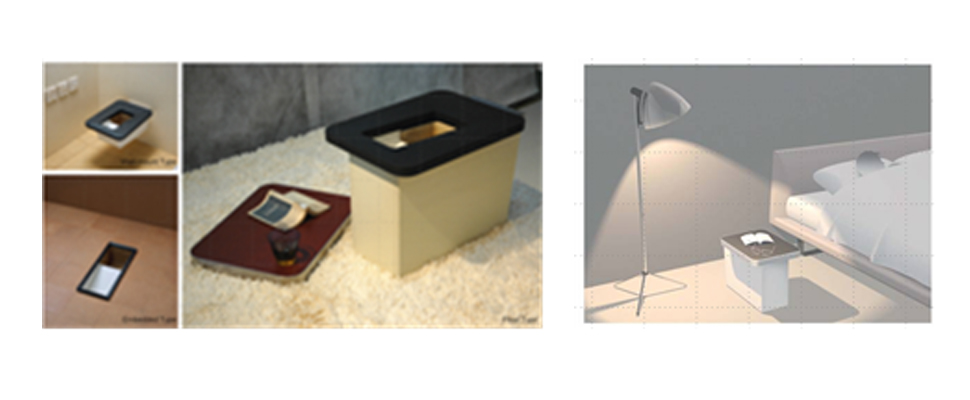
[Figure 4] Deposit Toilet
3. Design Process
Conventional ideas of “advanced design” are based on predictions of what society and the technology will be like in 3 to 5 year’s time. This can more accurately be termed “forecasting”. It is highly effective when looking at the near future, but often tends to suffer from the drawback of focusing too heavily on viability and immediately reaped benefits.
Furthermore, if there are large changes that have remained hidden and are waiting to happen, such as those involving environmental issues on a global scale, it can lead to extremely dangerous choices.
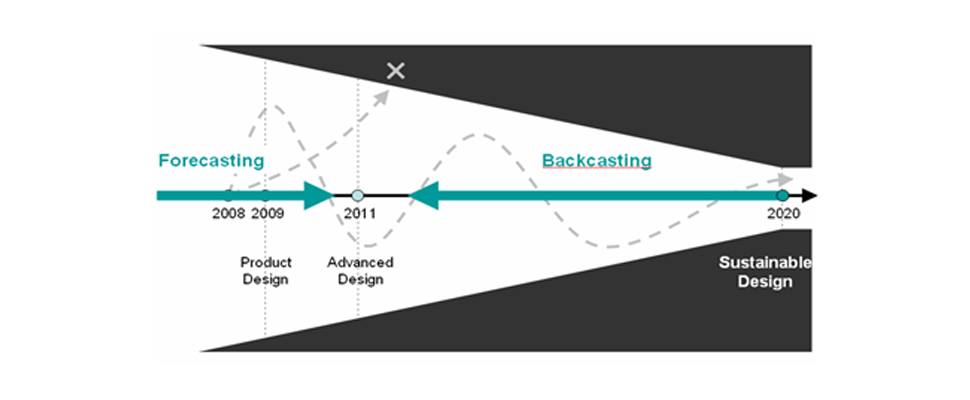
[Figure 4] “sustainable design” method
In order to prevent making the wrong choice over the long term, we have established goals to work toward, as a company. Since these goals have been designed looking 10 years into the future, they are innovative enough to break away from the present, yet at the same time do not rely too heavily on the realm of imagination. This is the “sustainable design” method that is based on such a sustainable future. It involves establishing what a sustainable society of the future should look like and then to look back from this future to the present and to think about what needs to be done by when. This method is known as “backcasting”.
As we create a new way of living, we are faced with issues related to the worsening global environment, the demographic and family structures that form the basis for living, and the changing values of individuals. In addition, the abnormal weather patterns caused by global warming may reach a point of no return before we know it. Though it easily escapes notice, the way we live still produces large amounts of waste and continues to use the earth’s resources and energy, and we have been unable to reduce carbon dioxide emissions. This is no longer a political problem – it has become a situation in which each of us must be conscious and go into action.
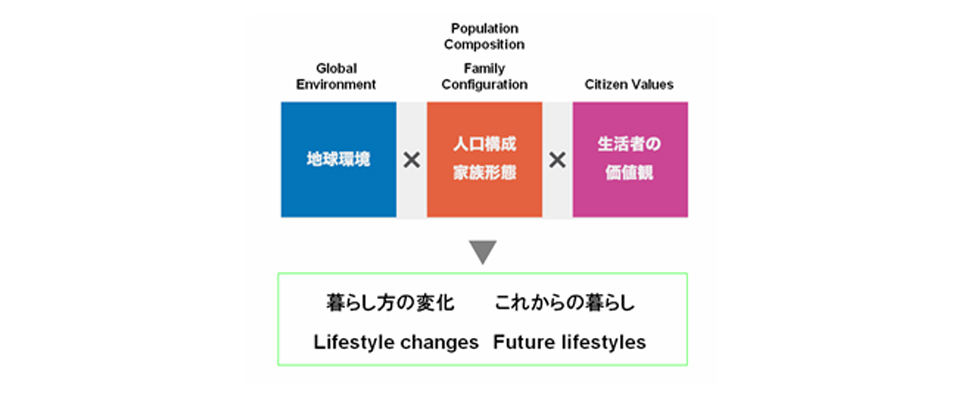
[Figure 5] LifeStyle Factor
What must also be taken into consideration are potential changes to our family structures and our values. Some have predicted that the typical family structure of today, which consists of 2 parents and 2 children will drastically change by the year 2020. There are projections that more than half of the population will consist of households made up of senior citizens living alone or in pairs, or young individuals living alone or with another peer, such as a spouse or a partner. This will drastically alter the family unit that we currently know of and take for granted.
The four-person dwelling, which is the core of our current business, may become a useless anachronism in the future. This one fact has been accepted at INAX as a very sobering reality. However, our business activities are still focused on products based on the four-person family, so it was decided that the issue of how to prepare for the future would be explored through research.
Moreover, there are also those that predict that people will shift from the current way of thinking, in which happiness is attained through material possessions, to one where individuals will be content not to directly own possessions, but to share them and lease them instead. In other words, a way of life that finds happiness not in material possessions, but in the simple act of living it self.
In Japan, automobile ownership is becoming less of a status symbol. Quite a few people are satisfied with renting music or downloading it. In days past, people had owning their own home as a life’s goal. Since the collapse of the bubble, land lost value and peoples’ lifestyles became fluid, and it has become harder to regard settling down and owning a house as the ideal situation. Rental housing up until recently has been inexpensive and not necessarily high in quality, but in recent years, there has been more high-quality rental housing – with projects involving architects – that it highly appealing to people in certain stages of life. One could say that it has become an age in which people can choose and live in a house that is suitable for their current lifestyle.
Next, we created the keywords for our Sustainable Style Project. They are “soku”, “chi”, “kyo”, and “so”. “Soku” means “quick”. The concept “mottainai”, which is a Japanese word meaning “wasteful” that has entered the international lexicon in recent years. “Soku” simply means removing the mottainai portions of a product as much as possible so that life can be lived efficiently without waste. “Chi”, which literally means “knowledge”, refers here to the idea of “slow” in “slow life”, which has its origins in the Slow Food movement, said to have started with the Italian love of food and exchanging knowledge of ingredients, cooks, and wine. This is why “slow” was translated as “chi” – living with so much enjoyment that nothing is wasted. “Kyo” means “cooperation”, and means living sharing wasteful things with others. “So” means “basic”. We hope that each person will become conscious of the concepts of “soku”, “chi”, “kyo”, and “so” and find a balance that feels comfortable that they can sustain. We have thought about options that can spur new ways of living based on the circumstances we are in and the issues that we will have to be aware of going forward.
The business that INAX can contribute with includes kitchens, baths, toilets, and building materials, but these elements are nothing but means to an end, and thus can be changed. Instead of thinking about product classes, we have decided to think about the acts associated with everyday life, which are eating, bathing, elimination, and habitation.
We are creating a concept that will be presented not as products of our imagination, but as a trip through a time machine to the year 2020, where we interview people of this future era. We also do not believe that the world will change solely because of our products, so we will imagine the various services that will be offered based on life in this future era, and we will work to raise our synergistic effects with these services to create a sustainable way of living in the future.
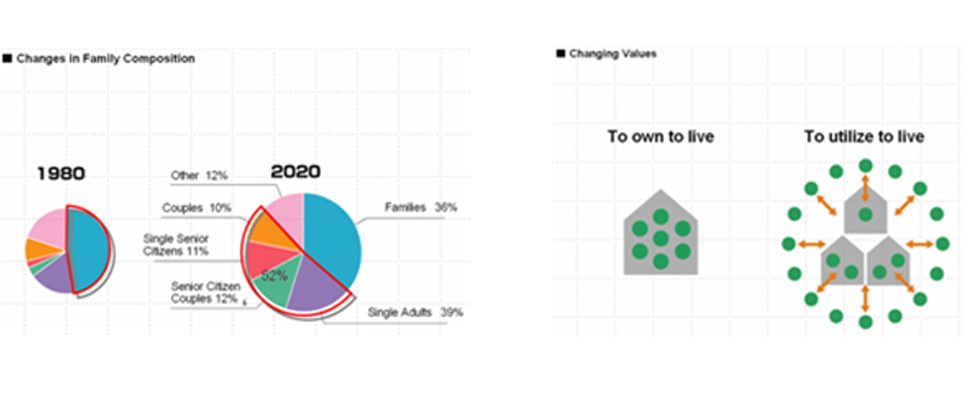
[Figure 6] Changes in Family Composition
[Figure 7] Changing various
At the same time, in exploring and bringing to realization, these cases of sustainable evidence, we must not forget to keep our own egotistic tendencies in constant check. To this end, we continue to seek out opportunities for us to share our ideas with those around us.
The level of consciousness in young people continues to surprise us. “That seems like a more comfortable way to live,” and “I want to live that way, so I hope you commercialize these products soon” is the type of feedback that we have received a lot of. We have also heard from people in their 50s who have been very open-minded in their feedback. “People lived like this a long time ago, so going back a bit isn’t an issue,” and “Isn’t this just a wonderful way to live?” are some examples.
Although we understand that some of our ideas may not gain universal acceptance from the start, we are more interested in the feedback that we receive, in the form of approval or even criticism. We hope to use this feedback to drive our actual product development process, which is the next step in our endeavor.
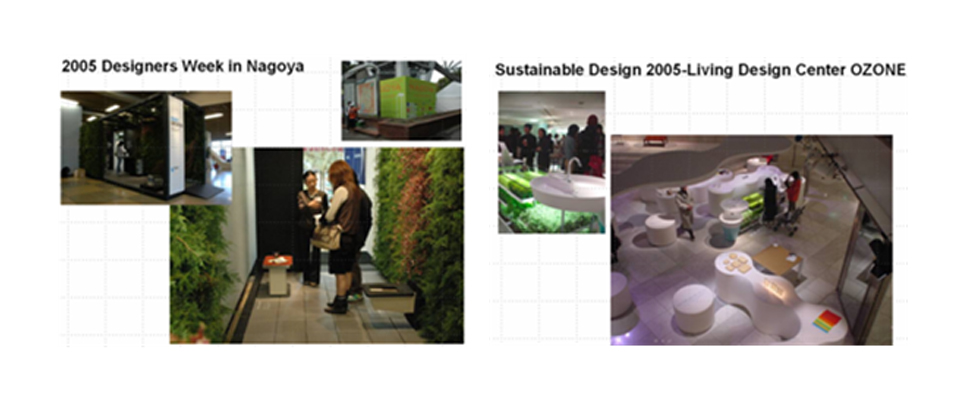
[Figure 8] For example sustainable design
4. Conclusion of Design
In conclusion, we believe that the future of sustainable design hinges upon the attitude that we should not force individuals to endure inconvenience or a monastic lifestyle, when dealing with environmental issues - rather, we should present them with an alternative lifestyle through which they can truly derive happiness and value. Furthermore, we believe that in order to bring to fruition such alternative lifestyles, we must continue to open ourselves up to the possibilities of boundless “creativity”.
These types of efforts have started to be recognized, and we received the Good Design Award in 2006 and the Kids Design Award in 2007. We were incredibly happy to have been told that we “sketched out a future that kids can believe in”.
The Sustainable Style Project that we have been engaged in is exists for the most part in our imaginations, and we have to quickly realize it in physical form. This is why in April 2008, we started a Sustainable Innovation Department that reports directly to our President. This department is working not only with Design but also with Engineering and R&D to determine how exactly to launch these products.
- JOURNAL
- CONFERENCE
- WORKSHOP
- EXHIBITION
- PUBLICATION
- OD BRAND
- ACTIVITY
- NEWS







